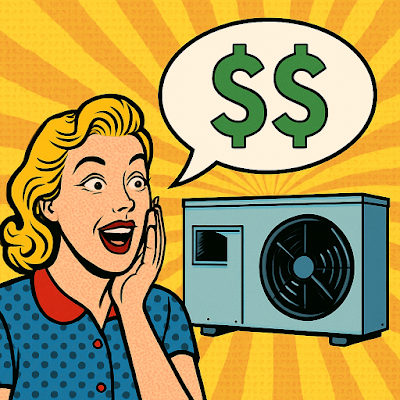On July 4, 2025, the One Big Beautiful Bill was signed into law. This legislation eliminates many rebates and tax credits for energy-efficient technologies, including solar panels, electric vehicles, and heat pumps. With these incentives disappearing, there's a narrowing window to adopt cost-saving, eco-friendly technologies, which are central to achieving energy efficiency and climate resilience.
Heat pumps are a cornerstone of modern energy efficiency. These systems work by transferring heat rather than generating it through combustion. They are ~50% more efficient than traditional heating methods like electric furnaces or baseboard heaters. They can be used heat and cool your home. To heat, they extract heat from the outside air and move it into your home. Even cold air has heat energy (on the Kelvin scale). Some cold-climate heat pumps can maintain effective operation down to -22°F (-30°C). To cool your home in the summer, they extract the heat from the warm are in your home and pump it outside. This is exactly the same way that modern AC units operate.
The efficiency of heat pumps translates into substantial savings on utility bills, often offsetting the initial installation cost over time. Providing both heating and cooling makes them a versatile solution for the increasingly variable climate, where summers bring intense heat and winters can dip into freezing temperatures. Environmentally, they are a game-changer, producing significantly fewer greenhouse gas emissions than fossil fuel-based systems.
For those concerned about extreme cold, a hybrid system pairing a heat pump with a high-efficiency furnace ensures reliable warmth year-round. In this setup, the heat pump handles heating during mild to moderately cold weather, operating at peak efficiency. When temperatures drop below the heat pump’s optimal range (typically 20-30°F, though newer models perform well in even lower temperatures), the high-efficiency furnace takes over. This combination minimizes furnace use, often reducing it to one-tenth of what it would be in a traditional system, slashing energy costs and extending the furnace’s lifespan. Hybrid systems offer the best of both worlds: the eco-friendly efficiency of a heat pump and the reliability of a furnace for the coldest days. This makes them an ideal choice for homeowners seeking to balance comfort, cost, and environmental impact.
The urgency to adopt heat pumps is heightened by the One Big Beautiful Bill’s impact. Federal incentives, which previously covered significant portions of heat pump installation costs (often up to $2,000 or more through tax credits), are being phased out, and many state-level rebates face funding uncertainty. You must act swiftly to capitalize on remaining incentives before they vanish.
To explore available opportunities, several resources provide comprehensive incentive information. The Database of State Incentives for Renewables & Efficiency (DSIRE), found at https://www.dsireusa.org/, is a leading platform detailing federal, state, and utility-specific rebates and tax credits for heat pumps and other energy-efficient technologies. The U.S. Department of Energy’s website (https://www.energy.gov/) offers guidance on federal programs and energy-saving tips, while Energy Star (https://www.energystar.gov/) helps users find certified heat pumps and locate local rebates. The Oregon Department of Energy’s website (https://www.oregon.gov/energy) provides updates on state initiatives, including those tied to the 2023 Climate Resilience package. Local utilities may also list regional incentives on their websites, often tailored to heat pump installations.
Move quickly and don't get left out in the cold.

No comments:
Post a Comment